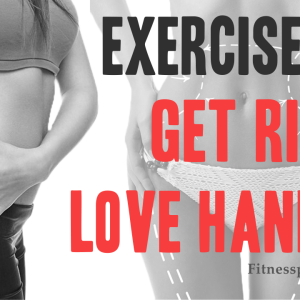Contents
If you’re on a quest for a wider and more defined back, the key lies in incorporating the right exercises that target various muscle groups. Achieving the coveted V-shaped physique involves working not only the latissimus dorsi but also engaging other supporting muscle groups in a balanced manner.
Before diving into the best back exercises for achieving an impressive V shape and width, it’s essential to familiarize yourself with the back muscles and supporting muscle groups that contribute to the appearance of a wide back. This knowledge will help you maximize the effectiveness of your back training.

Back Muscles to Focus on for Strength and Definition
1. Latissimus Dorsi (Lats): Superficial Back Muscle
- Description: The latissimus dorsi, commonly referred to as the “lats,” is an expansive muscle that spans the width of the middle and lower back.
- Importance: To create a wide back, prioritize exercises like pull-ups, lat pulldowns, and rows. Vary your grip to target different areas of the lats for comprehensive development.
2. Trapezius (Traps): Superficial Back Muscle
- Description: The trapezius, or traps, forms a triangular shape from the back of your neck to the middle of your back.
- Importance: Emphasize exercises like shrugs, face pulls, and upright rows to target the traps. Building well-defined traps contributes to the upper back’s width and gives a three-dimensional look.
3. Teres Major and Teres Minor:
- Description: The teres major connects the scapula to the upper arm, while the teres minor is a rotator cuff muscle in the posterior shoulder.
- Importance: Strengthen these muscles with exercises like bent-over lateral raises and external rotations. While teres major contributes to back width, teres minor is crucial for shoulder health, preventing injuries and ensuring balanced development.
4. Infraspinatus:
- Description: A thick triangular muscle in the rotator cuff group, located at the back of the shoulder.
- Importance: Incorporate exercises such as face pulls and external rotations to target the infraspinatus. While not directly impacting back width, a healthy infraspinatus is vital for overall shoulder function and stability.
5. Posterior Deltoid:
- Description: The posterior deltoid forms the back of your shoulder. The posterior deltoid is important because it is the roof of a wide ridge that you want to create. The posterior deltoid is often neglected, but one thing to remember is “The wider the shoulders, the more V-tapered your body looks”.
- Importance: To ensure a well-rounded shoulder development and contribute to a V-tapered physique, include rear delt flyes, reverse pec deck, and bent-over lateral raises in your routine.
6. Rhomboids (Major and Minor): Superficial Back Muscle
- Description: Skeletal muscles connecting the scapula with the vertebrae in the upper back.
- Importance: Strengthen rhomboids with exercises like seated cable rows and face pulls. These muscles, working in harmony with others, play a pivotal role in defining the upper back and creating a sculpted appearance.
7. Levator Scapulae: Superficial Back Muscle
- Description: A superficial back muscle located at the back and side of the neck.
- Importance: While not a primary contributor to back width, the levator scapulae plays a vital role in neck health. Include stretches and gentle exercises to maintain flexibility and prevent stiffness.
8. Erector Spinae:
- Description: Muscles that straighten and rotate the back, also known as spinal erectors. A strong spine is the foundation for a wide back. Developing the erector spinae not only enhances posture but also provides overall back strength for various physical activities.
- Importance: Strengthen your erector spinae with exercises like deadlifts, hyperextensions, and good mornings. A robust spine not only supports a wide back but also ensures proper posture and reduces the risk of injuries during various activities.
Putting It All Together:
In conclusion, building a wide and powerful back requires a strategic and balanced approach. By understanding the anatomy of the back muscles and tailoring your workout routine accordingly, you can progress towards your goal with confidence. Remember, it’s not just about the exercises you do but how effectively you target and engage each muscle group for optimal development.
Design a well-rounded workout routine that incorporates exercises targeting each of these muscle groups. Balance is key for achieving a wide back while ensuring strength and symmetry.
Best Back Exercises and Variations for a Comprehensive Back Workout
While it’s great to perform a good mix of moves that will target the back from all angles, the following seven exercise should form the foundation of your program.
1- Pull-ups
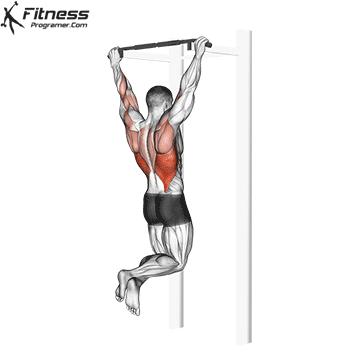
Target Muscles: Latissimus Dorsi
Secondary Muscles: Infraspinatus, Teres Minor, Rhomboids, Levator Scapulae, Teres Major
Pull-ups are recognized as one of the best back exercises, primarily targeting the latissimus dorsi, which is the broadest muscle in the back. Additionally, they engage the rhomboids, traps, rear deltoids, and biceps, making them a compound exercise that works multiple muscle groups simultaneously.
While they may seem daunting at first, mastering pull-ups can significantly contribute to building upper back strength and enhancing overall fitness. With proper form, consistent practice, and gradual progression, you can master this fundamental movement and unlock the full potential of your upper body strength.
Pull-ups offer versatility through different grip variations, allowing you to emphasize specific muscle groups. Common grips include wide grip, narrow grip, and reverse grip (chin-up), each targeting the muscles from a different angle.
Incorporating Grip Variation into Your Routine:
- Diversify Your Routine: Rotate between these grip variations to ensure a comprehensive workout that targets all aspects of your back.
- Progress Gradually: If you’re new to pull-ups, start with a grip that feels comfortable and gradually experiment with wider and narrower grips as your strength improves.
- Maintain Proper Form: Focus on a controlled and full range of motion. Avoid swinging or using momentum to ensure optimal muscle engagement.
Variations:
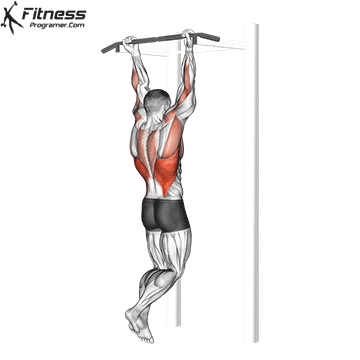
Chin-ups
While targeting the biceps, chin-ups also engage the muscles of the upper back, including the latissimus dorsi, rhomboids, and rear deltoids. This dual emphasis makes chin-ups a versatile exercise for overall upper body development.
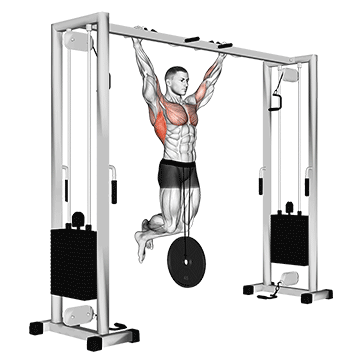
Weighted Pull-Ups
Attach some plate weight to your waist using a belt or alternatively, wear a weighted vest if you prefer. This way, you can boost the resistance of this move just the same as you would any other strength training exercise.
2- Barbell Row

Target Muscle: Latissimus Dorsi
Secondary Muscles: Erector Spinae, Rhomboids, Teres Minor, Trapezius, Teres Major, Infraspinatus, Posterior Deltoid
Barbell rows are renowned as one of the best back exercises due to their ability to engage multiple muscle groups simultaneously. The lats, rhomboids, traps, and rear delts all come into play, fostering comprehensive back development.
Moving along, now that you’ve done a vertical pulling movement, you want to balance this with a horizontal pulling exercise. This will ensure good muscular balance occurs and that you are hitting the muscles from all angles.
Just like with pull-ups, you’ll want to be sure that you perform this exercise in a very slow and controlled movement pattern. You should never jerk the weight upwards, using a swinging motion or you will instantly take muscular force out of the equation.
Instead, think of squeezing the elbows together, feeling the back muscles tighten and contract as you lift the weight up.
The back should also remain flat at all times, never assuming a hunched over position. If it does, you’ll put great strain on the back muscles and could eventually wind up experiencing an injury because of it.
Whether you’re seeking a wider back, improved muscle definition, or overall strength, this exercise provides a solid foundation for achieving your back workout goals.
Variations:
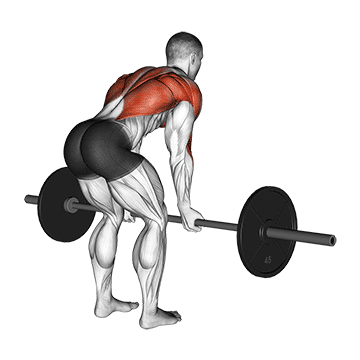
Underhand Barbell Rows
The underhand grip barbell row is excellent for increasing back width and will also help build up your biceps as well. Using the underhand grip is especially important here as it’s what will have you hitting the muscles at the angle necessary for maximum width gains.
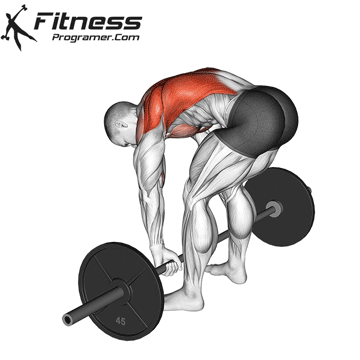
Pendlay Rows
In this variation, you start with the barbell on the ground between each repetition. This eliminates the stretch reflex and requires a full stop and reset for each row, emphasizing the back muscles.
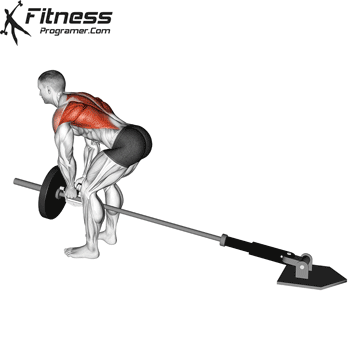
T-Bar Row
T-bar rows can be an alternative to barbell rows. By targeting the entire back chain, the movement will help you reach the wide back muscle you want and strengthen your back.
3- Wide Grip Seated Cable Row

Target Muscle: Latissimus Dorsi
Secondary Muscles: Erector Spinae, Teres Minor, Infraspinatus, Trapezius, Teres Major, Rhomboids, Levator Scapulae
One of the effective moves that you’ll want to consider adding to your workout program is the wide grip seated row. This is a great alternative to the barbell row noted above and is the right option for those who may be suffering from any sort of back issues.
Because you are sitting upright, you won’t be placing quite as much stress on the back, so will not have the same tension forces acting on your vertebrae.
When doing this move, you want to really think of pulling the weight back with just your back and not your arms, as many people have a tendency to call their biceps into play greatly when doing the exercise.
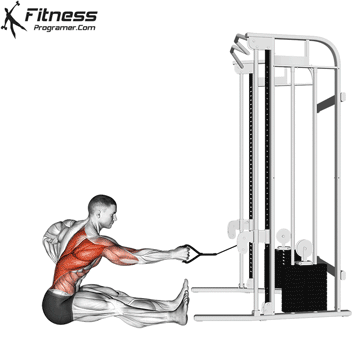
Single Stirrup Handle
The single stirrup handle allows for unilateral training, isolating one side of the back at a time. This helps address muscle imbalances and ensures each side receives equal attention and workload.
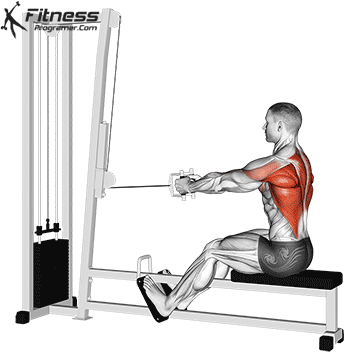
Close-grip (V-Grip Handle)
Bringing your hands close together with the close-grip handle targets the mid-back muscles, particularly the rhomboids. This variation intensifies the overall workout and contributes to upper back strength.
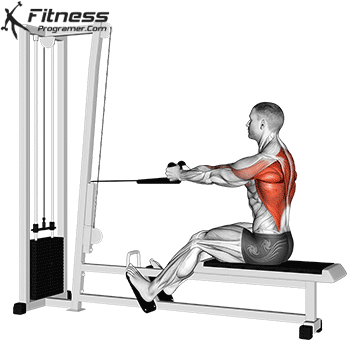
Rope Cable Row
The rope attachment adds a dynamic element to the cable row, targeting the lats and rear deltoids and improving shoulder strength. The increased range of motion enhances muscle engagement for a well-rounded upper back workout.
4- Lat Pulldowns:

Target Muscle: Latissimus Dorsi
Secondary Muscles: Levator Scapulae, Infraspinatus, Teres Minor, Posterior Deltoid, Traps, Rhomboids, Teres Major
Lat pulldowns are a foundational exercise that can significantly contribute to a strong, well-defined back. This compound movement primarily targets the latissimus dorsi, but it also engages other muscles such as the traps, rhomboids, and rear deltoids.
Lat pulldowns offer versatility through various grip options, allowing you to target different areas of the back. Common grips include V-bar, wide grip, narrow grip, and reverse grip (underhand grip).
Variations:
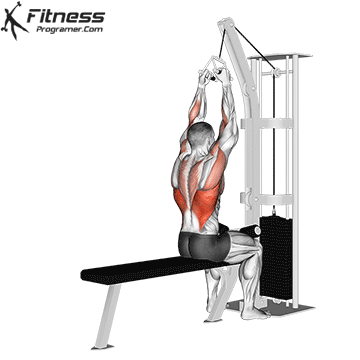
V-bar Lat Pulldown
The V-bar grip allows for a close and neutral hand position, targeting the inner portion of the lats. This variation provides an intense contraction in the center of the back, contributing to overall back thickness.
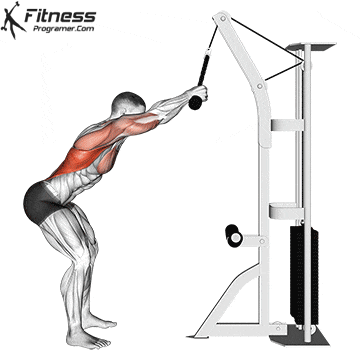
Straight-Arm Pulldown
The straight-arm pulldown excels at isolating the lats, ensuring focused attention on these muscles without unnecessary assistance from the shoulders or biceps.
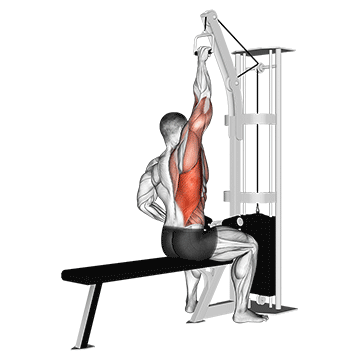
Single-Arm Lat Pulldowns:
Perform the exercise one arm at a time to address any muscle imbalances and enhance unilateral strength.
5- Dumbbell Rows
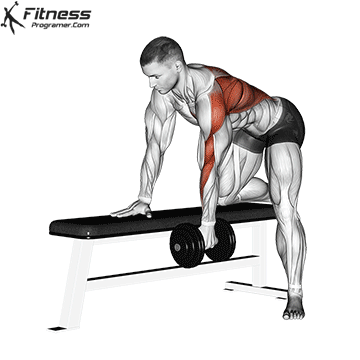
Target Muscle: Latissimus Dorsi
Secondary Muscles: Levator Scapulae, Teres Major and Minor, Trapezius, Rhomboids, Posterior Deltoid, Infraspinatus
Dumbbell rows are one of the best back exercises for building a symmetrical back. The primary muscles worked include the latissimus dorsi, rhomboids, traps, and rear deltoids.
Dumbbell rows allow for unilateral training, addressing any muscle imbalances between the left and right sides of your back. This unilateral focus can contribute to a more symmetrical physique.
To stabilize your body during the movement, your core muscles are engaged. This not only strengthens your core but also adds an element of functional fitness to the exercise.
Variations:
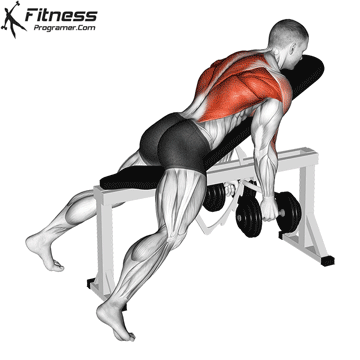
Incline Dumbbell Rows:
Execute the rows on an incline bench to change the angle of the movement, emphasizing the upper part of your back.

Renegade Rows:
From a plank position, row the dumbbells alternately, combining a back exercise with core activation.
6- Full Range of Motion Pulldown
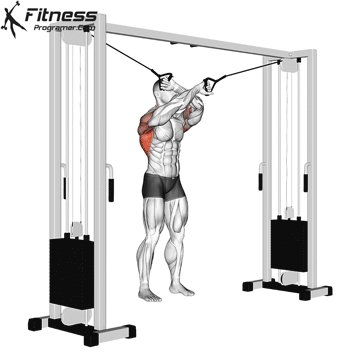
Target Muscle: Latissimus Dorsi
Secondary Muscles: Posterior Deltoid, Teres Minor, Infraspinatus, Trapezius, Teres Major, Rhomboids, Levator Scapulae
Another way to work the back muscles from different angles is the “Full Range of Motion Pulldown” exercise.
First of all, not only does it work pretty much all of your back musculature like your latissimus dorsi, traps, and rhomboids, but they also greatly enhance the role of the important scapular stabilizers, such as the posterior deltoid, teres muscles, and infraspinatus. It is recommended to perform this exercise in multi-repetition sets with light weights.
7- Deadlifts

Target Muscle: Gluteus Maximus
Secondary Muscles: Erector Spinae, Trapezius, Levator Scapulae, Rhomboids
One of the effective move to add to your workout is the deadlift. Now, you might be wondering – ‘but this is a lower body movement?’
And you are correct, it does work the lower body very well. But, in addition to that, it can also help you see excellent strength gains in your upper body also, namely, in your back.
The deadlift exercise is such a compound movement that you’ll almost hit virtually every muscle in your body, reaping great strength gains.
Deadlifts are such a powerhouse movement, do them first in any workout that you do so that you can perform with maximum effort.
From there, you can add other more targeted back exercises, furthering bringing on that state of fatigue.
Conclusion
In conclusion, building a wide and well-defined back is an achievable goal with strategic training and a balanced approach to exercise selection.
By strategically incorporating these exercises into your workout routine and adjusting rep ranges, you can target various aspects of back development, emphasizing width and creating a well-defined physique.
Strategic planning involves introducing 3-4 exercises per workout, varying rep ranges to include both lower (6-8) and higher (8-12) ranges. This approach ensures a continually changing stimulus on the muscles, fostering ongoing strength and size gains.
Remember to prioritize proper form, progressively overload the muscles, and allow for adequate recovery to achieve the desired results.


